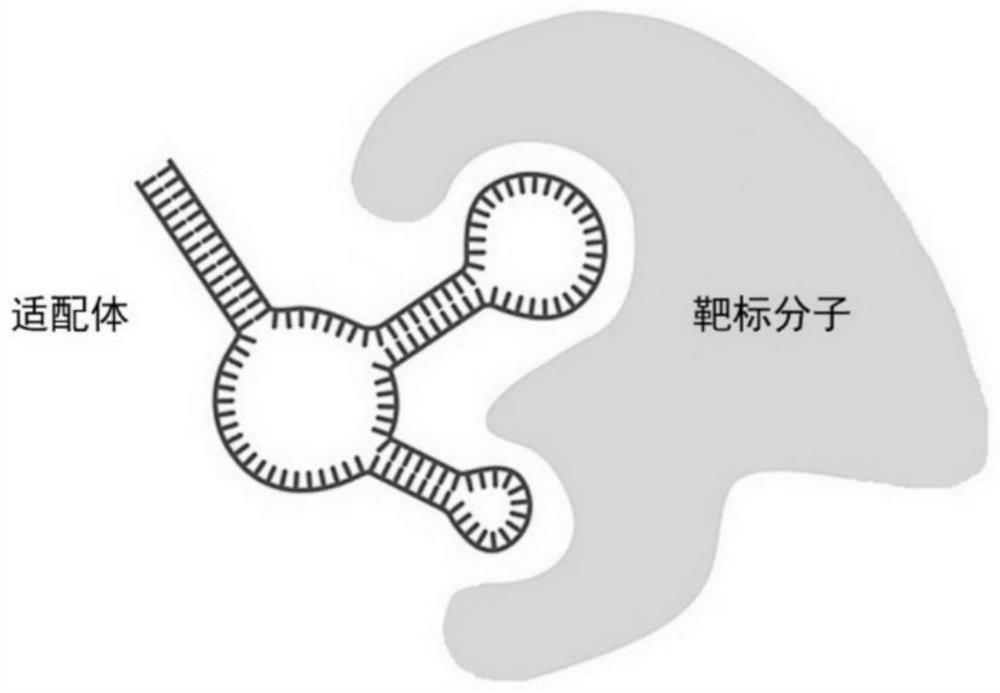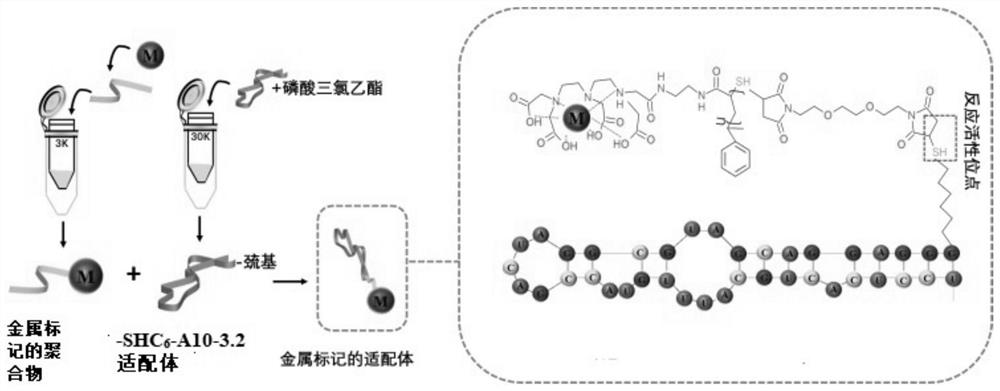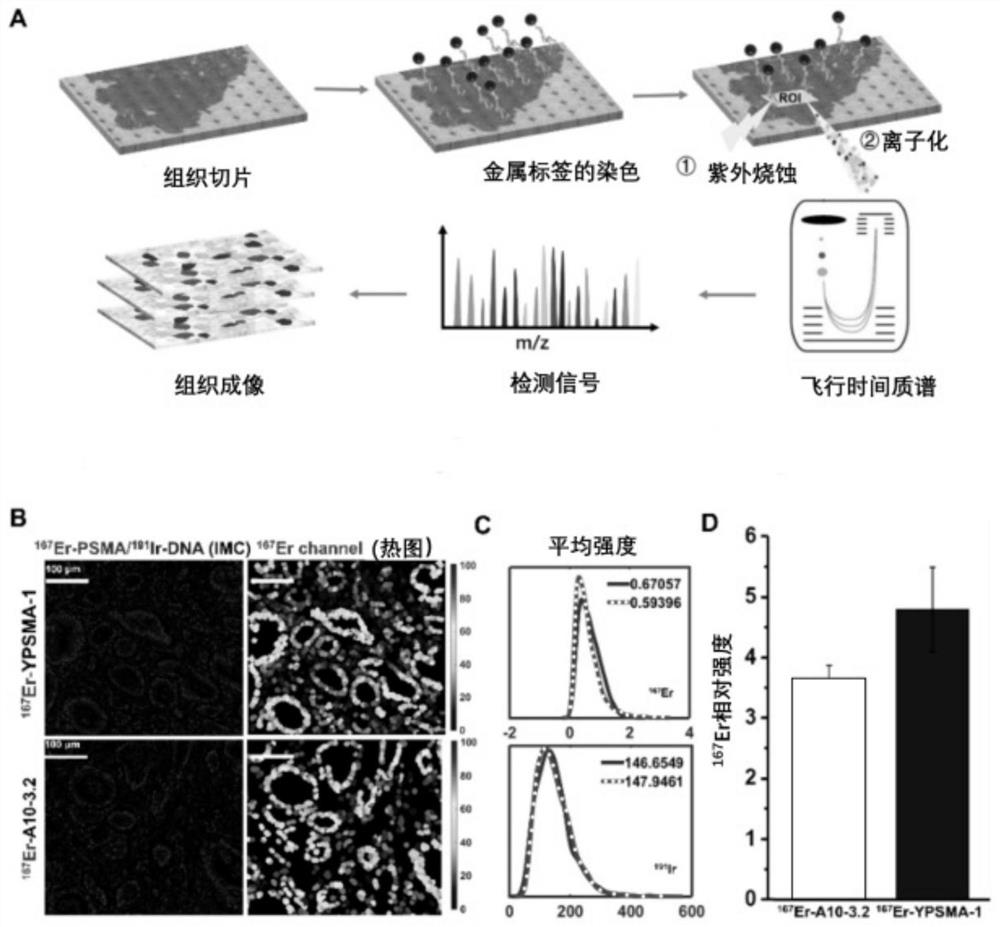Nucleotide aptamer-based metal probe as well as preparation method and application thereof
A technology of metal probes and aptamers, which can be used in the direction of material inspection products, measuring devices, instruments, etc., can solve the problems of Aptamer targeting limitations, etc., and achieve the effect of low price, small molecular weight, and good imaging effect
- Summary
- Abstract
- Description
- Claims
- Application Information
AI Technical Summary
Problems solved by technology
Method used
Image
Examples
Embodiment 1
[0038] Example 1 Principle of Nucleotide Aptamer Recognition Target Molecule
[0039] Nucleotide aptamers (Aptamers) are usually single-stranded DNA or single-stranded DNA that can bind to target antigens with high affinity and specificity produced in vitro through a process called ligand system evolution (SELEX). RNA oligonucleotides, ranging in length from 15 to 100 nucleotides. Such as figure 1 As shown, the nucleotide aptamer Aptamer recognizes the target molecule, and the combination of the two is an affinity binding process, and the binding body has a three-dimensional structure. The nucleotide sequence of the nucleotide aptamer Aptamer determines its three-dimensional structure that specifically binds to the target molecule. In addition, it can specifically recognize inorganic ions, small organic molecules, peptides, proteins, bacteria, viruses and cells.
Embodiment 2
[0040] Embodiment 2 The synthetic route of the metal probe based on nucleotide aptamer
[0041] Metal-labeled Aptamer probes 167 Er-A10-3.2 by 167 Er metal cations, bifunctional polymers, and -SHC 6 -A10-3.2 Nucleotide aptamer composition. First, triaminepentaacetic acid (DTPA) groups at the first end of the bifunctional polymer chelate 167 Er cations formed polymer-based lanthanide metal-chelating polymers (MCPs ( 167 Er)), where the number of metal ions is determined by the degree of polymer (DP) of the polymer. The DP of MCPs(Ln) polymer is generally 20-25. MCPs ( 167 Er) The maleimide functional group at the second end of the polymer and -SHC 6 The -SH of -A10-3.2 undergoes a Michael addition reaction, and a metal-labeled aptamer probe is synthesized.
[0042] Such as figure 2 As shown, the steps of the metal probe synthesis route based on nucleotide aptamers are:
[0043] Step 1 will 167 Er cations and bifunctional polymers were added to the ultrafiltration tu...
Embodiment 3
[0046] Embodiment 3 Ability of the specific recognition target of the metal probe based on nucleic acid aptamer
[0047] The transmembrane glycoprotein PSMA protein of epithelial cells in prostate cancer PaC tumor tissue slices was selected as the research object, and MCPs ( 167 Er) For the metal label, select Anti-PSMA-SHC 6 -A10-3.2 aptamer Aptamer and Anti-PSMA YPSMA-1 antibody as targeting groups, MCPs ( 167 Er) modified Ab and Aptamer prepared 167 Er-YPSMA-1 and 167 Er-A10-3.2 Two different types of probes. The successful construction of nanoprobes was verified by ultraviolet-visible absorption spectroscopy (UV-Vis) and transmission electron microscopy (TEM). Through traditional immunofluorescence imaging (Immunofluorescence imaging, IF) technology combined with IMC technology, the expression levels of PSMA in selected PaC tumor tissues and normal tissues were compared and analyzed; 167 Er-A10-3.2 and 167 The targeting ability of the Er-YPSMA-1 probe nanoprobe was v...
PUM
| Property | Measurement | Unit |
|---|---|---|
| degree of polymerization | aaaaa | aaaaa |
| strength | aaaaa | aaaaa |
| strength | aaaaa | aaaaa |
Abstract
Description
Claims
Application Information
 Login to View More
Login to View More - R&D
- Intellectual Property
- Life Sciences
- Materials
- Tech Scout
- Unparalleled Data Quality
- Higher Quality Content
- 60% Fewer Hallucinations
Browse by: Latest US Patents, China's latest patents, Technical Efficacy Thesaurus, Application Domain, Technology Topic, Popular Technical Reports.
© 2025 PatSnap. All rights reserved.Legal|Privacy policy|Modern Slavery Act Transparency Statement|Sitemap|About US| Contact US: help@patsnap.com



